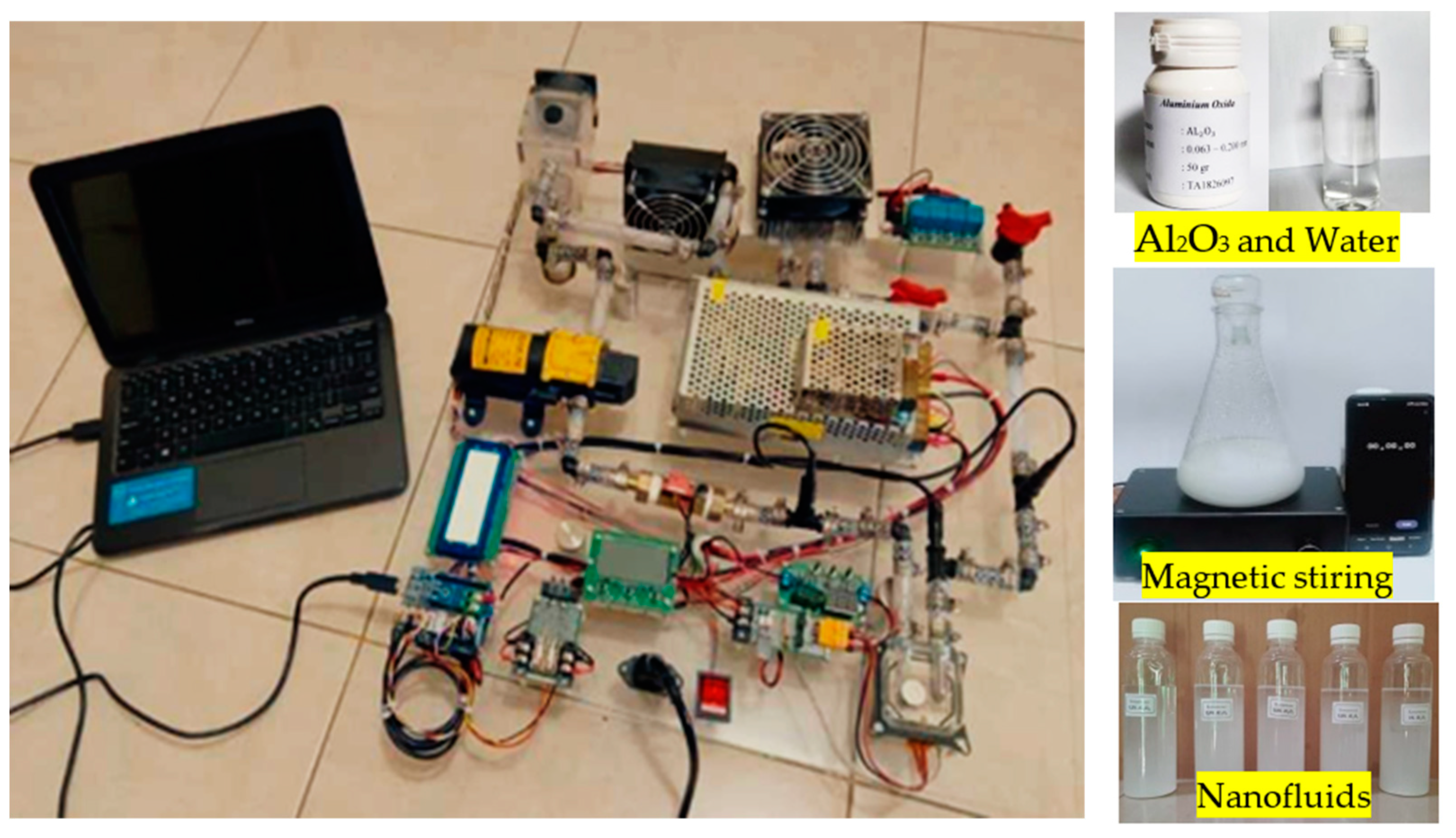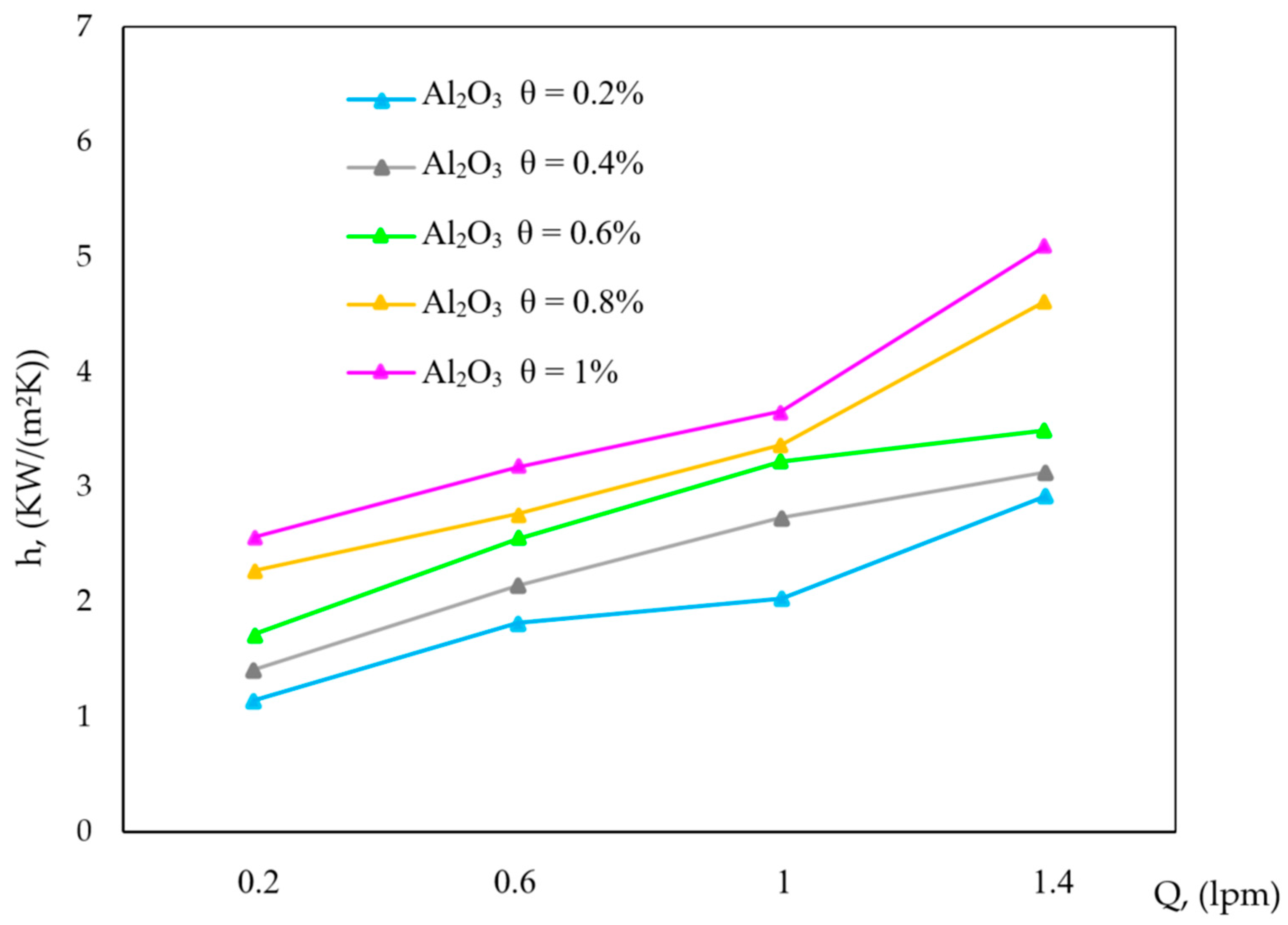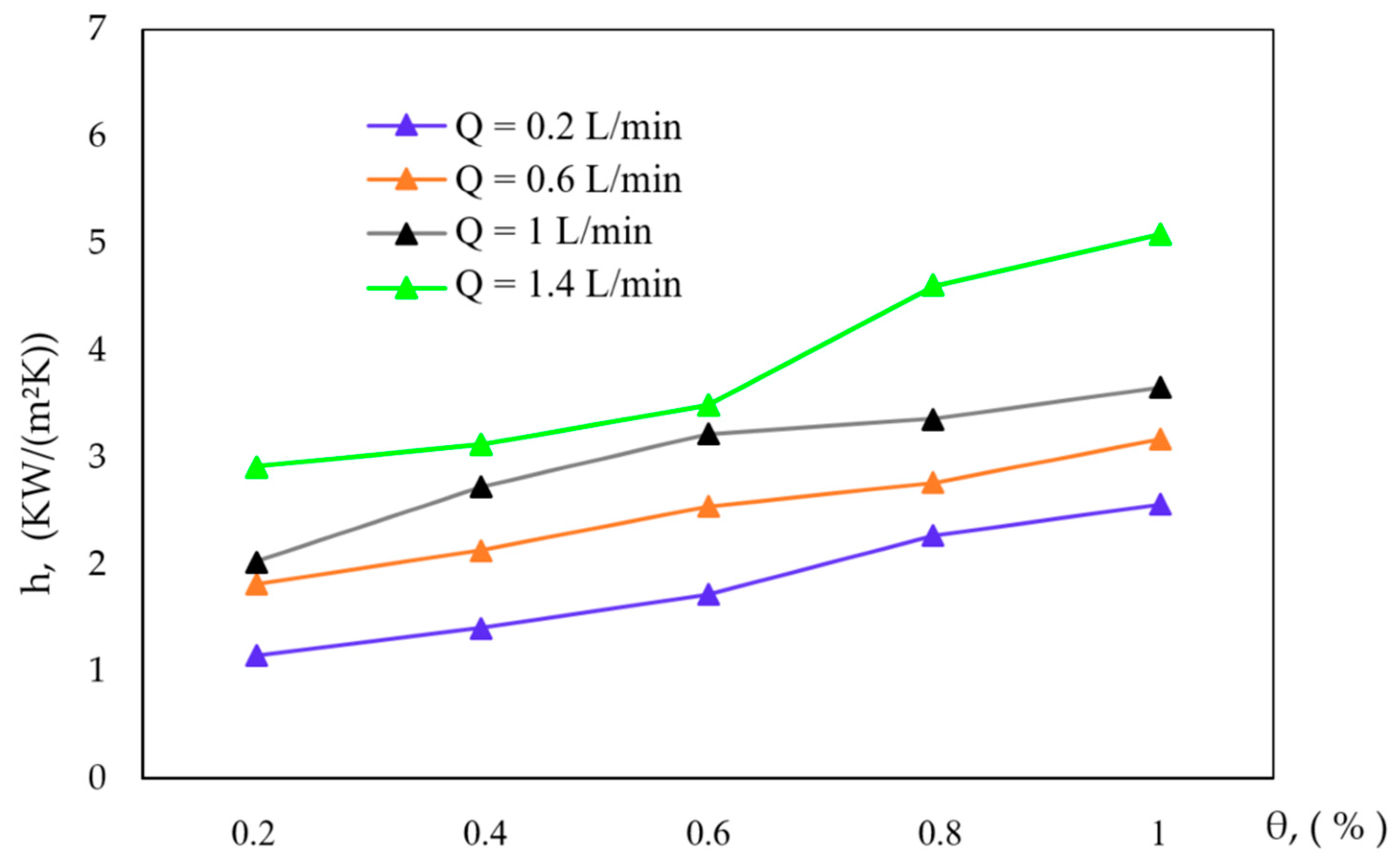Enhancing Heat Dissipation in Microchannel Heat Sinks: A Comprehensive Study on Al2O3 Nanoparticle Concentration and Flow Rate Dependencies †
Abstract
1. Introduction
2. Research Method
3. Results and Discussions
3.1. The Convective Heat Transfer Coefficient of Water
3.2. The Influence of Varying Concentrations of Al2O3 Fractions on the Convective Heat Transfer Coefficient
3.3. The Relationship between Flow Rate and Convective Heat Transfer Coefficient
3.4. The Level of Uncertainty Present
4. Conclusions
Author Contributions
Funding
Institutional Review Board Statement
Informed Consent Statement
Data Availability Statement
Acknowledgments
Conflicts of Interest
References
- Pordanjani, A.H.; Aghakhani, S.; Afrand, M.; Sharifpur, M.; Meyer, J.P.; Xu, H.; Ali, H.M.; Karimi, N.; Cheraghian, G. Nanofluids: Physical phenomena, applications in thermal systems and the environment effects—A critical review. J. Clean. Prod. 2021, 320, 128573. [Google Scholar] [CrossRef]
- Effendy, M.; Yao, Y.F.; Yao, J. Effect of Mesh Topologies on Wall Heat Transfer and Pressure Loss Prediction of a Blade Coolant Passage. Appl. Mech. Mater. 2013, 315, 216–220. [Google Scholar] [CrossRef]
- Wang, R.; Yuan, W.; Wang, J.; Zhu, Z. Parametric investigation on a micro-array heat sink with staggered trapezoidal bumps. Micromachines 2019, 10, 845. [Google Scholar] [CrossRef] [PubMed]
- Murshed, S.M.S.; Leong, K.C.; Yang, C. A combined model for the effective thermal conductivity of nanofluids. Appl. Therm. Eng. 2009, 29, 2477–2483. [Google Scholar] [CrossRef]
- Munimathan, A.; Sathish, T.; Mohanavel, V.; Karthick, A.; Madavan, R.; Subbiah, R.; Masi, C.; Rajkumar, S. Investigation on Heat Transfer Enhancement in Microchannel Using Al2O3/Water Nanofluids. Int. J. Photoenergy 2021, 2021, 6680627. [Google Scholar] [CrossRef]
- Chen, M.; He, Y.; Huang, J.; Zhu, J. Investigation into Au nanofluids for solar photothermal conversion. Int. J. Heat Mass Transf. 2017, 108, 1894–1900. [Google Scholar] [CrossRef]
- Al-Waeli, A.H.A.; Chaichan, M.T.; Kazem, H.A.; Sopian, K. Comparative study to use nano-(Al2O3, CuO, and SiC) with water to enhance photovoltaic thermal PV/T collectors. Energy Convers. Manag. 2017, 148, 963–973. [Google Scholar] [CrossRef]
- Raja, M.; Vijayan, R.; Dineshkumar, P.; Venkatesan, M. Review on nanofluids characterization, heat transfer characteristics and applications. Renew. Sustain. Energy Rev. 2016, 64, 163–173. [Google Scholar] [CrossRef]
- Prakash, A.; Satsangi, S.; Mittal, S.; Nigam, B.; Mahto, P.K.; Swain, B.P. Investigation on Al2O3 Nanoparticles for Nanofluid Applications—A Review. In Proceedings of the IOP Conference Series: Materials Science and Engineering, Sikkim, India, 8–10 December 2017; Institute of Physics Publishing: Bristol, UK, 2018. [Google Scholar] [CrossRef]
- Rafati, M.; Hamidi, A.A.; Shariati Niaser, M. Application of nanofluids in computer cooling systems (heat transfer performance of nanofluids). Appl. Therm. Eng. 2012, 45–46, 9–14. [Google Scholar] [CrossRef]
- Anggono, A.D.; Riswanto, D.; Ismoen, M.; Masyrukan, M.; Hariyanto, A.; Sedyono, J. Effect of flow rate and CNM concentration in nanofluid on the performance of convective heat transfer coefficient. Front. Mech. Eng. 2023, 9, 1174185. [Google Scholar] [CrossRef]
- Ho, C.J.; Wei, L.C.; Li, Z.W. An experimental investigation of forced convective cooling performance of a microchannel heat sink with Al2O3/water nanofluid. Appl. Therm. Eng. 2010, 30, 96–103. [Google Scholar] [CrossRef]
- Willink, R. On revision of the guide to the expression of uncertainty in measurement: Proofs of fundamental errors in bayesian approaches. Meas. Sensors 2022, 24, 100416. [Google Scholar] [CrossRef]
- Riyadi, T.W.B.; Setiadhi, D.; Anggono, A.D.; Siswanto, W.A.; Al-Kayiem, H.H. Analysis of mechanical and thermal stresses due to TiN coating of Fe substrate by physical vapor deposition. Forces Mech. 2021, 4, 100042. [Google Scholar] [CrossRef]




| Parameter | Average Uncertainty |
|---|---|
| Heat transfer coefficient (Q = 0.2 lpm) | ±0.030 |
| Heat transfer coefficient (Q = 0.6 lpm) | ±0.017 |
| Heat transfer coefficient (Q = 1 lpm) | ±0.017 |
| Heat transfer coefficient (Q = 1.4 lpm) | ±0.026 |
| Parameter | Average Uncertainty |
|---|---|
| Heat transfer coefficient (θ = 0.2%) | ±0.029 |
| Heat transfer coefficient (θ = 0.4%) | ±0.036 |
| Heat transfer coefficient (θ = 0.6%) | ±0.038 |
| Heat transfer coefficient (θ = 0.8%) | ±0.053 |
| Heat transfer coefficient (θ = 1%) | ±0.042 |
Disclaimer/Publisher’s Note: The statements, opinions and data contained in all publications are solely those of the individual author(s) and contributor(s) and not of MDPI and/or the editor(s). MDPI and/or the editor(s) disclaim responsibility for any injury to people or property resulting from any ideas, methods, instructions or products referred to in the content. |
© 2024 by the authors. Licensee MDPI, Basel, Switzerland. This article is an open access article distributed under the terms and conditions of the Creative Commons Attribution (CC BY) license (https://creativecommons.org/licenses/by/4.0/).
Share and Cite
Ngisomudin; Anggono, A.D.; Effendy, M.; Ngafwan. Enhancing Heat Dissipation in Microchannel Heat Sinks: A Comprehensive Study on Al2O3 Nanoparticle Concentration and Flow Rate Dependencies. Eng. Proc. 2024, 63, 15. https://doi.org/10.3390/engproc2024063015
Ngisomudin, Anggono AD, Effendy M, Ngafwan. Enhancing Heat Dissipation in Microchannel Heat Sinks: A Comprehensive Study on Al2O3 Nanoparticle Concentration and Flow Rate Dependencies. Engineering Proceedings. 2024; 63(1):15. https://doi.org/10.3390/engproc2024063015
Chicago/Turabian StyleNgisomudin, Agus Dwi Anggono, Marwan Effendy, and Ngafwan. 2024. "Enhancing Heat Dissipation in Microchannel Heat Sinks: A Comprehensive Study on Al2O3 Nanoparticle Concentration and Flow Rate Dependencies" Engineering Proceedings 63, no. 1: 15. https://doi.org/10.3390/engproc2024063015
APA StyleNgisomudin, Anggono, A. D., Effendy, M., & Ngafwan. (2024). Enhancing Heat Dissipation in Microchannel Heat Sinks: A Comprehensive Study on Al2O3 Nanoparticle Concentration and Flow Rate Dependencies. Engineering Proceedings, 63(1), 15. https://doi.org/10.3390/engproc2024063015





